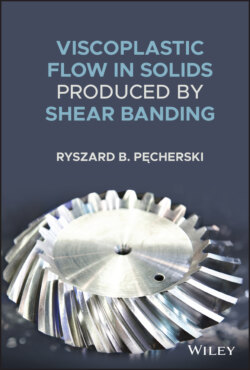Читать книгу Viscoplastic Flow in Solids Produced by Shear Banding - Ryszard B. Pecherski - Страница 10
1.3.2 KOBO Processes Resulting in Viscous Effects
ОглавлениеThe experimental investigations and microscopic analysis of the substructure of metals and alloys carried out by Korbel and Bochniak investigation group led to the novel observation of viscous effects of deformation processes by the KOBO method. The results presented in the papers by Korbel et al. (2011), Bochniak et al. (2011, 2013) indicate that the point defects of supra‐equilibrium concentration, generated in periodically variable conditions of plastic flow in the course of the KOBO process, play a decisive role. The massive production of point defects leads to the superplastic behaviour of metallic solid not observed in other plastic‐forming methods. The authors state that: ‘It seems reasonable, therefore, to conclude that die oscillation frequency (torsion of material) is the determinant of the amount of point defects and its increase should enhance the process. The occurrence of diffusing atoms or vacancies stream equalising the concentration leads to a significant decrease in viscosity of the material, generating an alternative to the dislocation slip mechanism of plastic deformation’, cf. (Korbel et al. 2011), p. 2893. The analysis justifies the author's view that the mechanism of metal extrusion using the mentioned KOBO technology is induced by the intensive generation of point defects. Thus, the authors hypothesise that a viscous flow with ‘Newtonian fluid’ features is a dominant deformation mechanism in KOBO processes. Generally, they identify the description of deformation occurring, e.g. during extrusion by the KOBO method as viscoplastic flow. However, on the other hand, in deformable solids' mechanics, the early viscoplasticity model belongs to Bingham (1916). It shows the linear dependency of shear stress on shear strain rate:
where τ0 is yield stress in shear and denotes the shear strain rate. Neglecting τ0 = 0, one arrives at the linear model of ‘Newtonian fluid’. An analogy with magnetorheological materials appears here. From the papers of Frąś (2015), Frąś and Pęcherski (2018), it seems that the linear Bingham model does not conform to experimental data contrary to the original nonlinear viscoplasticity model of Perzyna (1963). The similar conclusion leads the above discussion on a viscous flow resulting from the massive production of point defects activated in KOBO processes. In my view, a more comprehensive theory of the viscoplastic flow produced by shear banding is in order. The observation about the importance of viscous effects accompanying rate‐dependent plastic flow during KOBO processes is accounted for in the book.
